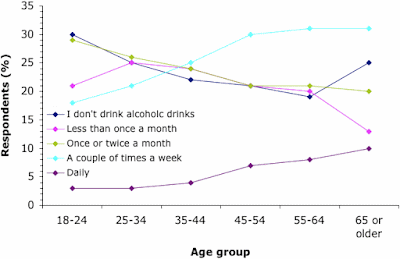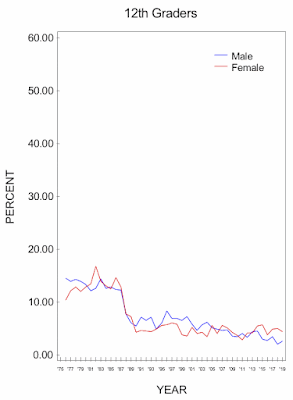For alcohol, the lower limit is zero (we don't actually need alcohol in our lives); and approaching the upper limit leads to what is politely referred to as “alcohol use disorder”. The latter, if pursued fervently enough, leads to physical problems (like liver damage), behavioral issues (such as depression), and even an early death. In the wine industry, we should care about these things.*
In this regard, we have been told recently that alcohol use is decreasing among recent generations (see the first graph, showing Alcohol consumption frequency in the UK in 2019/2020). Indeed, the so-called Baby Boomers were the most recent cohort of people to widely adopt alcohol consumption as a hobby (as well as a sport, in some cases). What has been less widely reported is that, in many places, the males are decreasing their alcohol consumption faster than are the females, so that alcohol consumption is now greater among the latter group.
It has long been a truism that alcohol consumption by men exceeds that of women, on average. This is physiological, as much as behavioral. The possession of a womb, used for child-bearing, means that female physiology differs quite dramatically from that of males. You only have to compare hand temperature during cold weather, to know that female blood circulation is quite different from that of males, for example.** So, we have previously expected females to react more strongly than males to alcohol.
A change in consumption bias towards females is therefore a trend of great biological as well as sociological interest. Let's look at some of the data.
We could start with a broad review of the published literature. In the paper on: Birth cohort trends in the global epidemiology of alcohol use and alcohol-related harms in men and women: systematic review and metaregression, 68 published studies are reviewed. The authors' conclusion is that:
Among those born in the early 1900s, males were 2.2 times more likely than females to consume alcohol, 3.0 times more likely to drink alcohol in ways suggestive of problematic use, and 3.6 times more likely to experience alcohol-related harms. [By contrast,] among cohorts born in the late 1900s, males were 1.1 times more likely than females to consume alcohol, 1.2 times more likely to drink alcohol in ways suggestive of problematic use, and 1.3 times more likely to experience alcohol-related harms.
So, the previous 3:1 ratio for risky drinking habits in men versus women is now closer to 1:1, globally. Looking at the paper's graphs, the move towards equality became obvious among people born in the first half of the 1970s (ie. in their late 40s now). This is the cohort known as Generation X. The move to equality was more or less complete among the Millennial cohort. (Generation Z is not included in the review.)
If we now focus on younger people, since they seem to be the relevant group, there are surveys available from the USA (Demographic Subgroup Trends among Adolescents in the Use of Various Licit and Illicit Drugs, 1975-2019), with data collated as tables and figures (2019 National Survey of Drug Use and Health (NSDUH) Releases: Key Substance Use and Mental Health Indicators in the United States).
This next graph shows data from that survey concerning the prevalence of reported lifetime alcohol use for both males (blue line) and females (pink line) among people aged 12 to 20. While there has been a continual decline through time in the percentage of people reporting that they have consumed alcohol, in both groups, for the past 10 years females have consistently out-performed the males.
If we now focus on people 17-18 years old (ie 12th graders) converging trends have been observed for measurements involving reported recent drinking (as opposed to lifetime drinking), as reported in: Gender differences in the epidemiology of alcohol use and related harms in the United States. Here is one figure from that paper, illustrating what percentage of 12th graders in each year have reported alcohol consumption.
If we focus on wine alone, rather than all alcohols, we see similar trends for the same age group. The next graph shows the prevalence of reported wine consumption during the 30 days prior to the survey, with the data starting from 1976. Note that the sudden drop in 1988 is probably caused by changing the survey questions to add a separate one about wine coolers (which had become very popular).
Note that, once again, for the past 10 years females have consistently out-performed the males. A similar thing is observed for the prevalence of having 5 or more drinks in a row (ie. getting drunk), as shown in the next graph.
So, through time, fewer and fewer young people are reporting alcohol consumption, but the females have not decreased as much as the males, so that their prevalence is now higher. The data seem to be quite consistent about this pattern among younger generations — this was first reported, as far as I know, back in 2015 (Male and female drinking patterns becoming more alike in the US).
At the risk of sounding facetious, this sort of gender equality is probably not what the Women's Liberation movement originally intended; but it may well be an inevitable consequence of achieving that equality, which must include the bad as well as the good. [Being equal to males is not necessarily to be recommended!]
A recent NPR article summarizes many of the sociological issues associated with drinking parity between the sexes, given that, on average, alcohol affects women more strongly than men (Women now drink as much as men — not so much for pleasure, but to cope). A discussion of the technical literature is available in: Sex differences in stress-related alcohol use.
As has also been reported, US adults have increased their alcohol consumption during the Covid-19 pandemic. As part of this, women have, on average, notably increased their heavy drinking episodes (4 or more drinks within a couple of hours), as discussed in: Changes in adult alcohol use and consequences during the Covid-19 pandemic in the US.
* High Consumption for males has been considered to be 14 "standard drinks" per week, with 9 such drinks for females. Intensive Consumption for males is 5 drinks at any one time, with 4 drinks for females. A Standard Drink is 330 ml of beer, 120 ml of wine, or 40 ml of spirits.
** Females produce all of their eggs at sexual maturity, and then release one every month or so, until they run out. So, they need to protect their ovaries at all times, lest they unintentionally become infertile. In cold weather, their blood circulation preferentially protects their ovaries, at the expense of their hands, toes, ears and nose. Males can produce new sperm at any time, and so they do not need to protect their testes from cold weather, to the same extent. They do, however, need to protect them from violent physical attack!







No comments:
Post a Comment